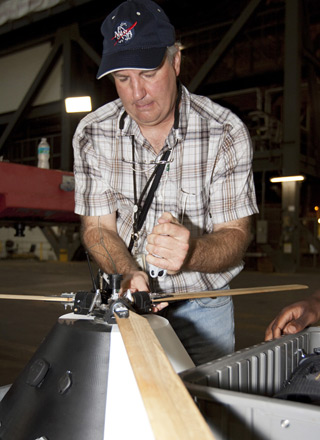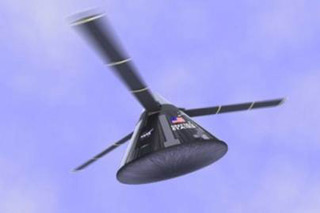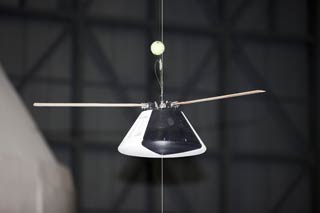 NASA engineer Jeff Hagen prepares a scale model for drop tests in the Vehicle Assembly Building at Kennedy Space Center. NASA photo.
NASA engineer Jeff Hagen prepares a scale model for drop tests in the Vehicle Assembly Building at Kennedy Space Center. NASA photo.
NASA engineers hope to prove spacecraft can land under rotors, autorotating to a soft landing in exactly the same fashion as a helicopter. The concept is being developed first at a small scale, with a series of small models drop tested inside the massive Vehicle Assembly Building at Kennedy Space Center, using some basic technology provided by the hobby industry: a radio-controlled helicopter kit.
Jeff Hagen, an engineer based at the Johnson Space Center, said autorotation has a significant advantage over parachute recovery: The landing can be much softer and precisely controlled. A spacecraft of the future that deploys rotors (after slowing to subsonic speed in the atmosphere) could touch down on a specific target at near-zero vertical and horizontal speed, a distinct advantage over parachute-aided landings that are safe for humans and basic cargo, but bad for some of the more sensitive experiments carried aboard the International Space Station. Hagen said rotors offer another advantage: relative simplicity, when compared to the parachute and rocket-assisted landing system developed to put the rover Curiosity on Mars, or the combination of rockets, parachutes, and airbags used on previous Martian missions, for example.
“We certainly don’t anticipate that this is something that would require decades of intense effort,” Hagen said.
There are technical challenges, particularly when it comes to stowing and deploying the rotor blades during launch and flight. Engineers have only begun to devise telescoping rotors that can neatly stow away beneath the aeroshell, starting first with a basic proof-of-concept test—using scale models that incorporate off-the-shelf parts from hobby shops.
“We’re operating, essentially, on a shoestring budget,” Hagen said. Students in a senior design class at Rice University in Houston have been called on to pitch in, and NASA engineer Jim Meehan took a crash course, so to speak, in flying helicopters.
 NASA engineers believe rotors could prove a practical method for slowing spacecraft to a gentle landing. NASA image.
NASA engineers believe rotors could prove a practical method for slowing spacecraft to a gentle landing. NASA image.
“I actually did a Google search on how to do an autorotation landing,” Meehan recalled. In a series of recent tests, models were dropped from the upper levels of the Vehicle Assembly Building at Kennedy Space Center, starting 480 feet up with Meehan perched on a platform about halfway down controlling the rotor pitch (collective) using a standard radio controller. In the early tests, the model was connected to a guide wire, with foam padding at the base in case the landing was a little off. Future tests are planned that will push pilot skills a little farther with free flight. The ultimate system will likely be controlled by a computer for unmanned vehicles, though manned spacecraft will likely offer the astronauts on board some degree of control over the autorotation landing.
 A model capsule used by NASA to test the rotor design. Photo credit: NASA/Kim Shiflett
A model capsule used by NASA to test the rotor design. Photo credit: NASA/Kim Shiflett
Rotors could also be used to recover spent rocket boosters, and just about anything else that benefits from a soft landing after reentry.
If the concept sounds familiar, that’s because it is. Engineers considered using rotors to land Apollo capsules; more recently, a private company called Rotary Rocket attempted to create a spacecraft that used rotors for more than just landing. The Roton, which wound up on display at Mojave Spaceport after the company went bust in 2001, was to have used a combination of rotor and rocket for takeoff and climb, as well as landing.
“That had a lot of challenges to it,” Hagen noted.



